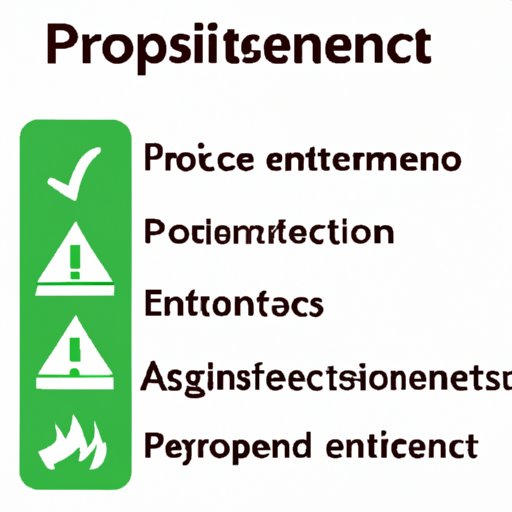Introduction
The precautionary principle is a concept that has been used throughout history to guide decision-making about environmental protection. Its underlying idea is that when there is uncertainty about the potential risks of a particular action or inaction, it is best to err on the side of caution and take protective measures. This article will explore the definition, origins, benefits and limitations of the precautionary principle, as well as provide case studies from around the world and discuss how it can be applied to current environmental challenges.

Definition of the Precautionary Principle
The precautionary principle is defined as “a course of action that is taken in anticipation of harm, even though full scientific certainty about the harm is not yet established” (Environment Protection and Heritage Council, 2001). In other words, it is a system of risk management that incorporates the idea of caution in order to protect people and the environment from potential risks. The principle has been enshrined in various international agreements and treaties, including the 1992 Rio Declaration on Environment and Development and the 1998 Protocol to the Convention for the Protection of the Marine Environment of the North-East Atlantic.
Overview of its Origins and Relevance
The modern version of the precautionary principle was first articulated in the 1970s in response to increasing public concern about the potential impacts of new technologies and industrial processes on the environment. It was initially developed in Germany, where it was referred to as the “Vorsorgeprinzip”, which translates to “foresight principle” (Fischer et al., 2018). Since then, the principle has been adopted by many countries and organizations around the world as a way of managing potentially risky activities, such as the use of pesticides, genetically modified organisms, and nuclear energy.

Benefits and Limitations of the Precautionary Principle
Benefits of Adopting the Precautionary Principle
The primary benefit of adopting the precautionary principle is that it encourages decision-makers to consider the potential risks associated with an action or inaction before taking any steps. This allows for a more informed decision-making process, as it takes into account both the potential risks and rewards of an action. By doing so, it helps to prevent irreparable damage to the environment or human health.
Limitations of the Precautionary Principle
Despite its potential benefits, the precautionary principle has several limitations. One of the main criticisms of the principle is that it may lead to overregulation, as decision-makers may be too cautious in their approach. Additionally, the principle does not provide clear guidance on how to weigh the potential risks and rewards of an action. As a result, decision-makers may struggle to make informed decisions in complex situations.

Case Studies from Around the World
Examples of the Precautionary Principle in Action
The precautionary principle has been put into practice in a variety of contexts around the world. For example, in Europe, the principle has been used to regulate the use of agricultural chemicals and genetically modified organisms (Fischer et al., 2018). In the United States, the principle has been used to implement restrictions on the use of certain hazardous substances, such as asbestos, lead, and mercury (Gardner et al., 2012). Additionally, the principle has been used in Canada to regulate the use of nanomaterials (Gibson et al., 2015).
Lessons Learned from these Case Studies
These case studies demonstrate the potential of the precautionary principle to effectively manage risks in a variety of contexts. They also highlight the importance of considering both the potential risks and rewards of an action before making a decision. Finally, they illustrate the need for clear guidance on how to apply the principle in order to ensure that it is used effectively.
Applying the Precautionary Principle to Environmental Challenges
Understanding Risk and Reward
In order to effectively apply the precautionary principle to environmental challenges, it is important to understand both the potential risks and rewards of an action. This means assessing the potential impacts on both human health and the environment, as well as considering economic, social, and cultural factors. Additionally, decision-makers should be aware of the potential for unintended consequences, as some actions may have both positive and negative effects.
Making Informed Decisions about the Environment
Once the potential risks and rewards of an action have been assessed, decision-makers must decide whether or not the action should be taken. This decision should be based on an informed evaluation of the available evidence and an understanding of the potential impacts of the action. If the potential risks are deemed to outweigh the potential rewards, then the action should not be taken. On the other hand, if the potential rewards are seen to outweigh the potential risks, then the action may be taken, provided that appropriate safeguards are in place.
Conclusion
Summary of the Precautionary Principle
The precautionary principle is a concept that has been used throughout history to guide decision-making about environmental protection. Its underlying idea is that when there is uncertainty about the potential risks of a particular action or inaction, it is best to err on the side of caution and take protective measures. The principle has been adopted by many countries and organizations around the world as a way of managing potentially risky activities, such as the use of pesticides, genetically modified organisms, and nuclear energy.
Final Thoughts on Environmental Protection
The precautionary principle is an important tool for managing environmental risks. However, it is important to remember that it is only one part of the puzzle when it comes to protecting the environment. In order to effectively address environmental challenges, decision-makers must take into account all of the available evidence and consider both the potential risks and rewards of an action before making a decision.
(Note: Is this article not meeting your expectations? Do you have knowledge or insights to share? Unlock new opportunities and expand your reach by joining our authors team. Click Registration to join us and share your expertise with our readers.)
